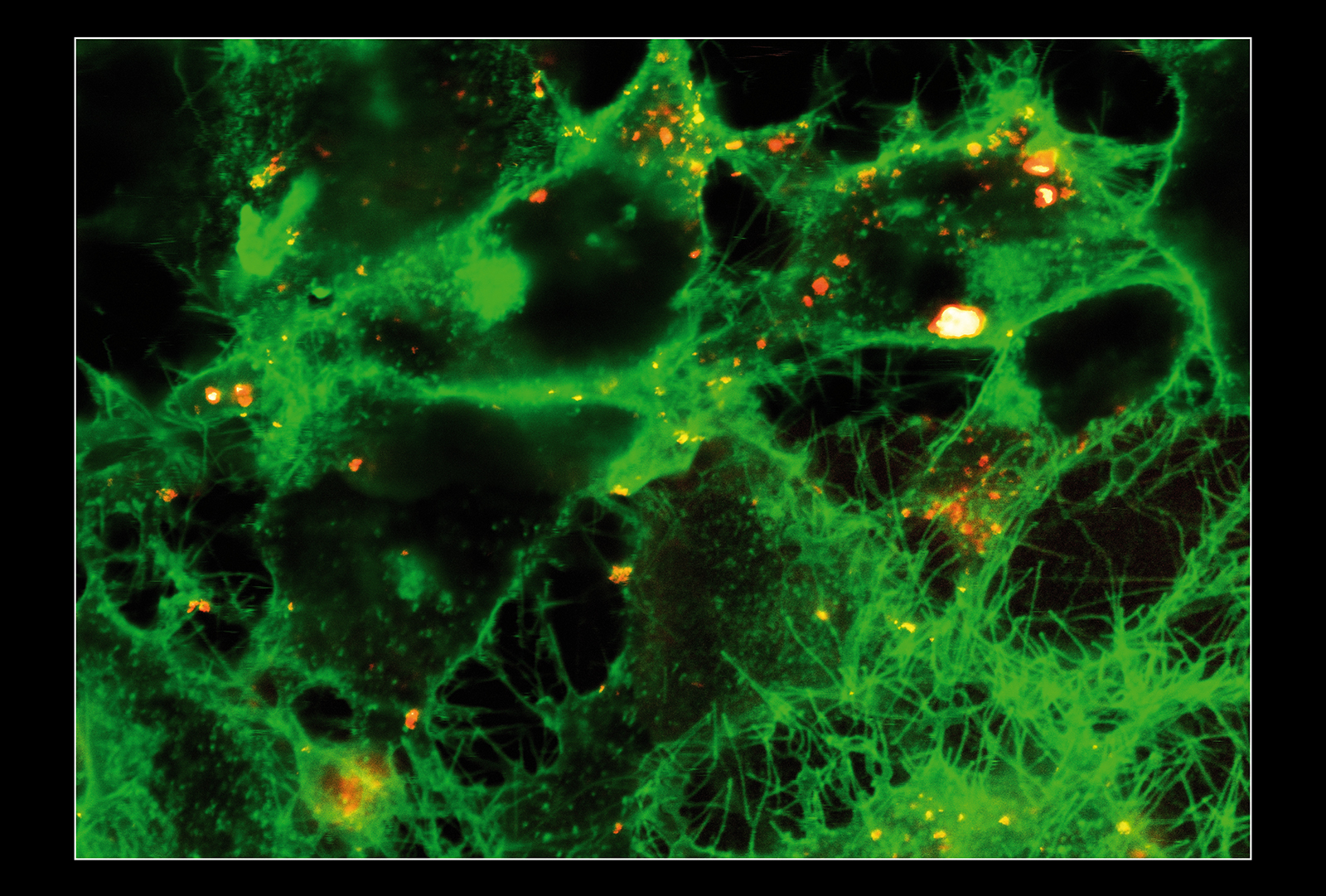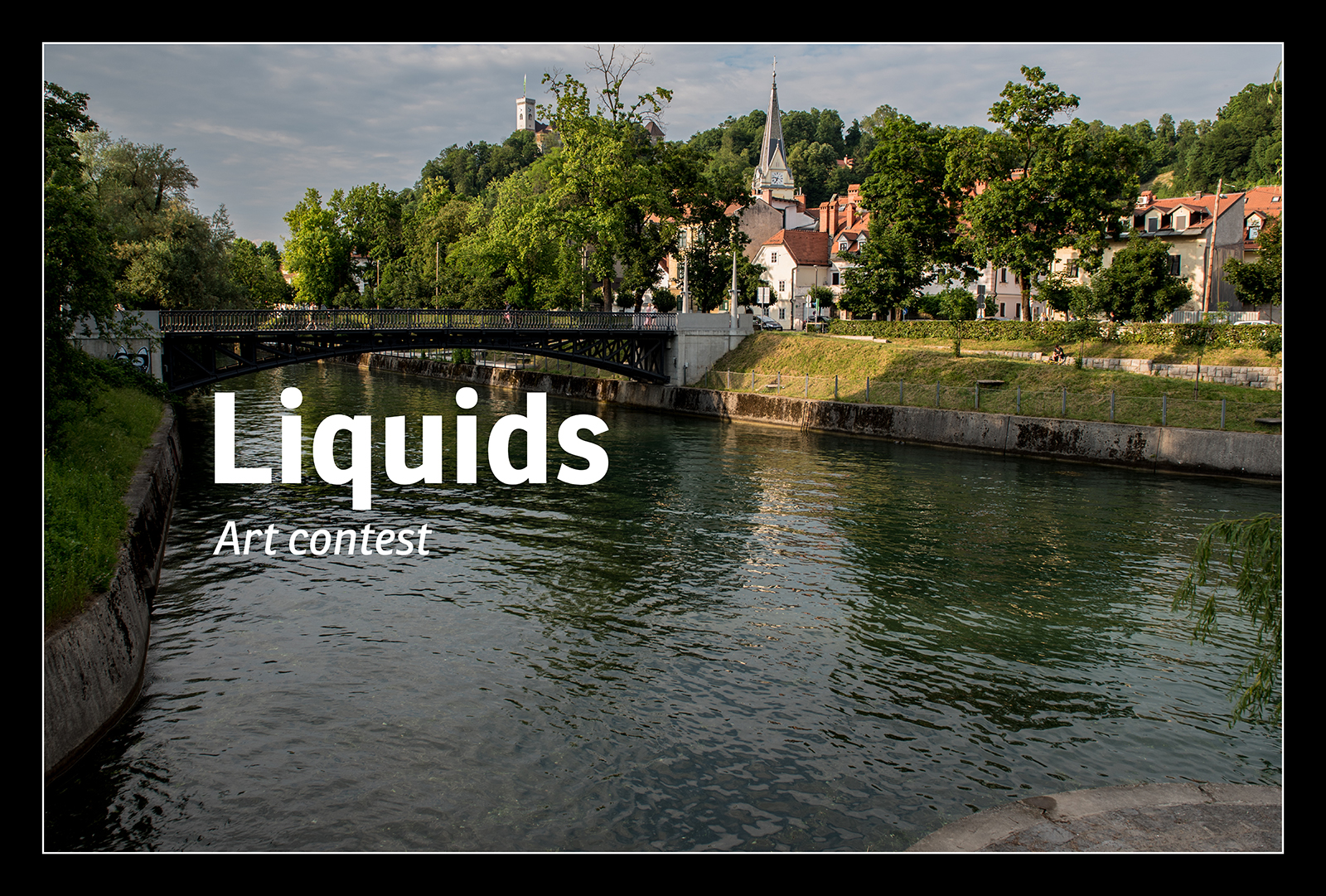
Gold nanoparticle tree branches
Department of Chemical Engineering, Indian Institute of Technology, Guwahati, Assam, India
Nanoparticles of gold behave and look very different from solid gold, and have extraordinary electro-optical properties. They can be used for chemical sensors, drug delivery and photovoltaic applications.
After evaporation, a nanoliter droplet of gold solution with dyes forms a beautiful structure, which looks like the branches of a tree.
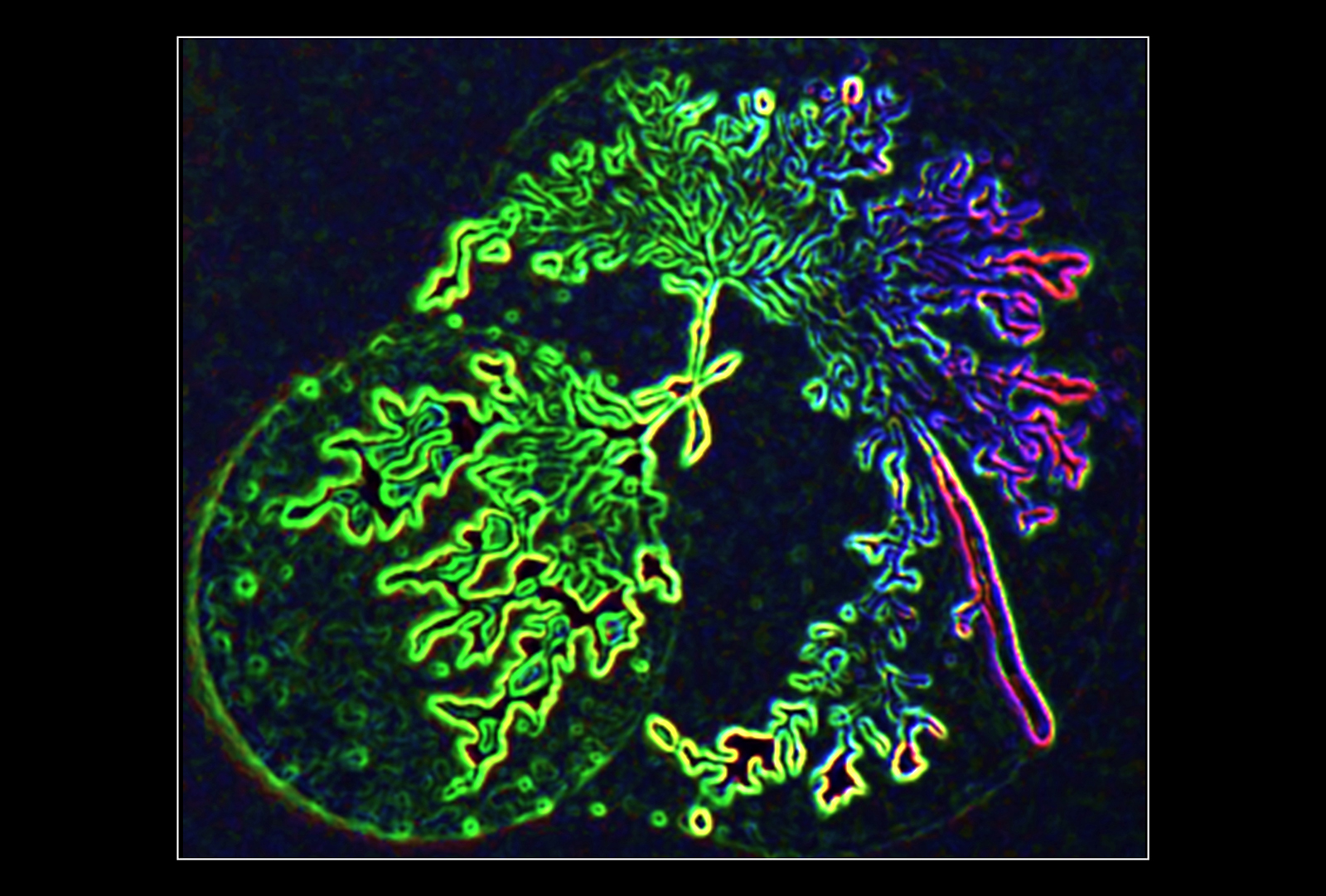
Domain pattern of nematic ordering after a sudden temperature-driven phase transition
Jožef Stefan Institute, Ljubljana, Slovenia
This polarizing optical microscopy image shows a moment in the rapid cooling of confined nematic liquid crystal. One can observe the formation of tiny nematic domains that start to appear out of the disordered isotropic phase. The snapshot was captured at an exposure time of few nanoseconds.
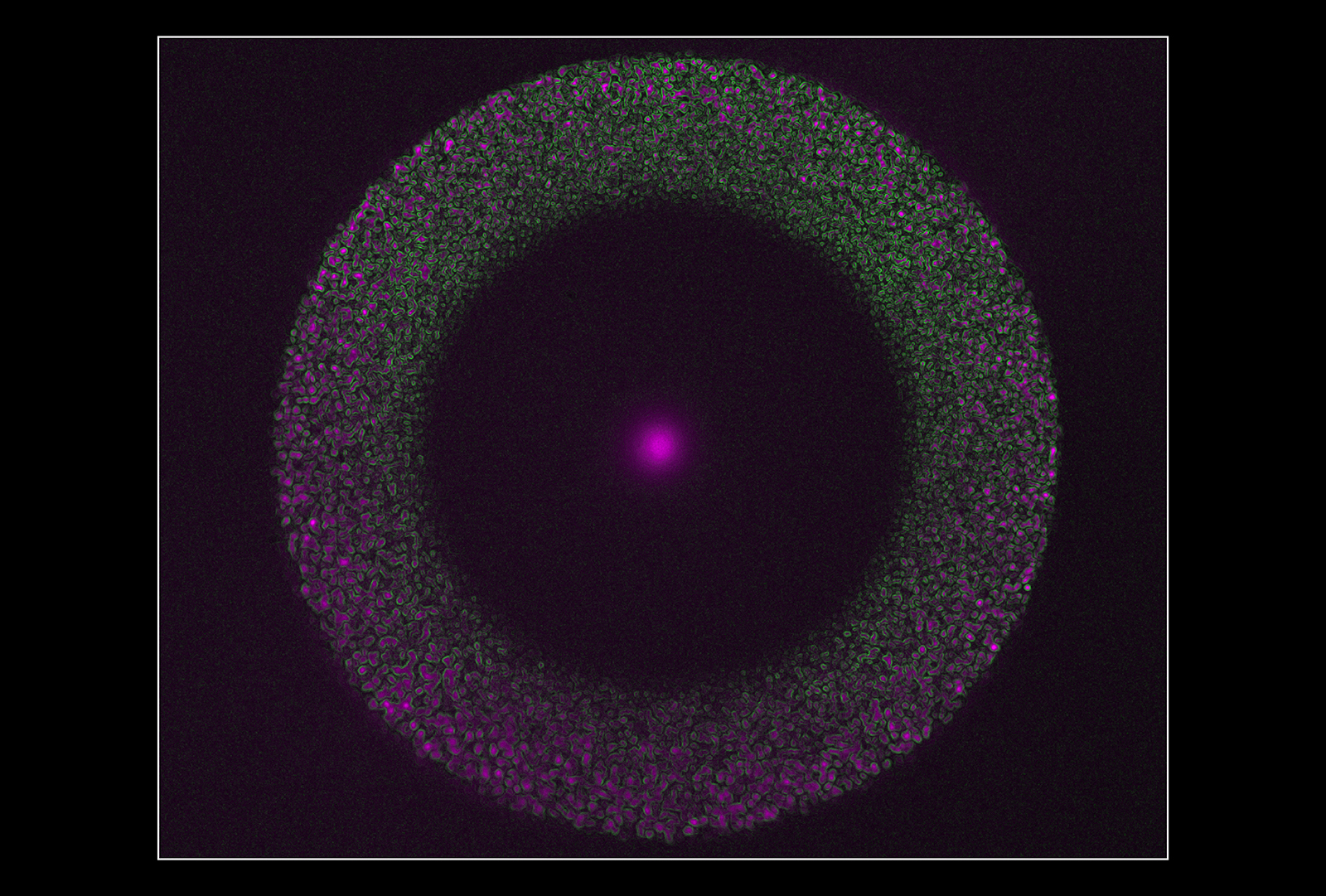
Thinning nematic liquid crystal film on the surface of a water droplet
Jožef Stefan Institute, Ljubljana, Slovenia
The polarizing optical microscopy image shows 8CB liquid crystal, positioned at the edge of a large water droplet. Under crossed polarizers the water appears black, whereas the liquid crystal exhibits a wide selection of colors due to its birefringence. In the center, the liquid crystal is in the smectic phase and a rough focal conic texture can be observed. At the edge of the water droplet, the liquid crystal is in the nematic phase. Fringes in the film tell us that its thickness is changing – the film gets thinner the further away from the bulk liquid crystal it gets.
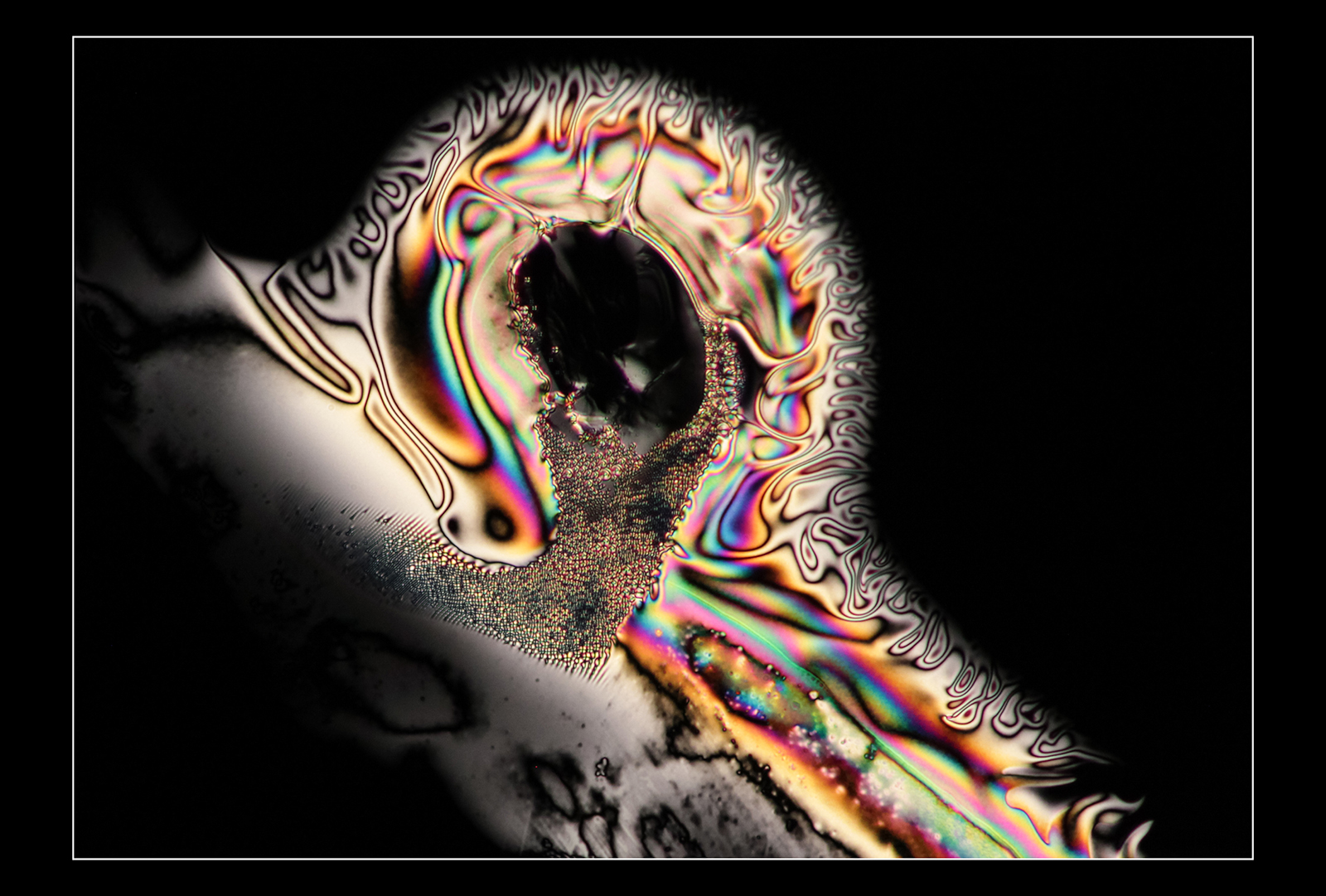
Smectic banana plantation
Jožef Stefan Institute, Ljubljana, Slovenia
In liquid crystals all directions are not alike and show different light propagation velocities depending on the direction and polarization of light. In this way, when placed under the microscope between crossed polarizers a characteristic birefringent texture of the material can be observed. This photograph shows a typical texture of columnar smectic liquid crystal phase formed by banana-shaped molecules, colloquially called this way because of their bent-shaped molecular structure.
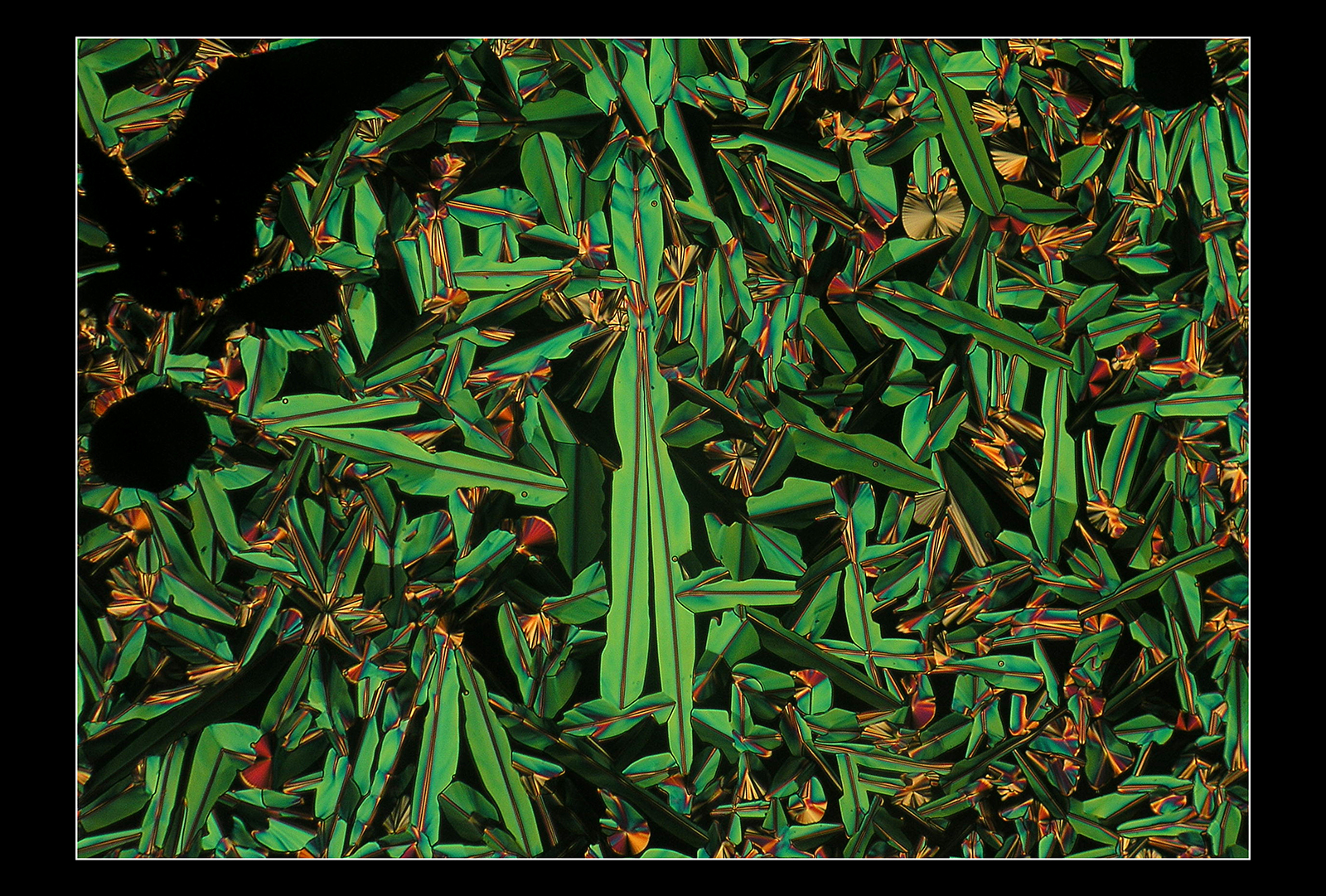
Two boojums
Liquid Crystal Institute, Kent State University, Ohio, U.S.A.
A micrometer-thick film of a nematic liquid crystal with degenerate orientation of molecules produces topological point defects, the so-called boojums that locate at the bottom of the film. When viewed between two crossed polarizers, the film shows dark brushes that mark the places with molecules oriented along the polarization plane of the polarizers and interference colors between the brushes. The interference colors vary as the liquid crystal molecules change their tilt from one point to other.
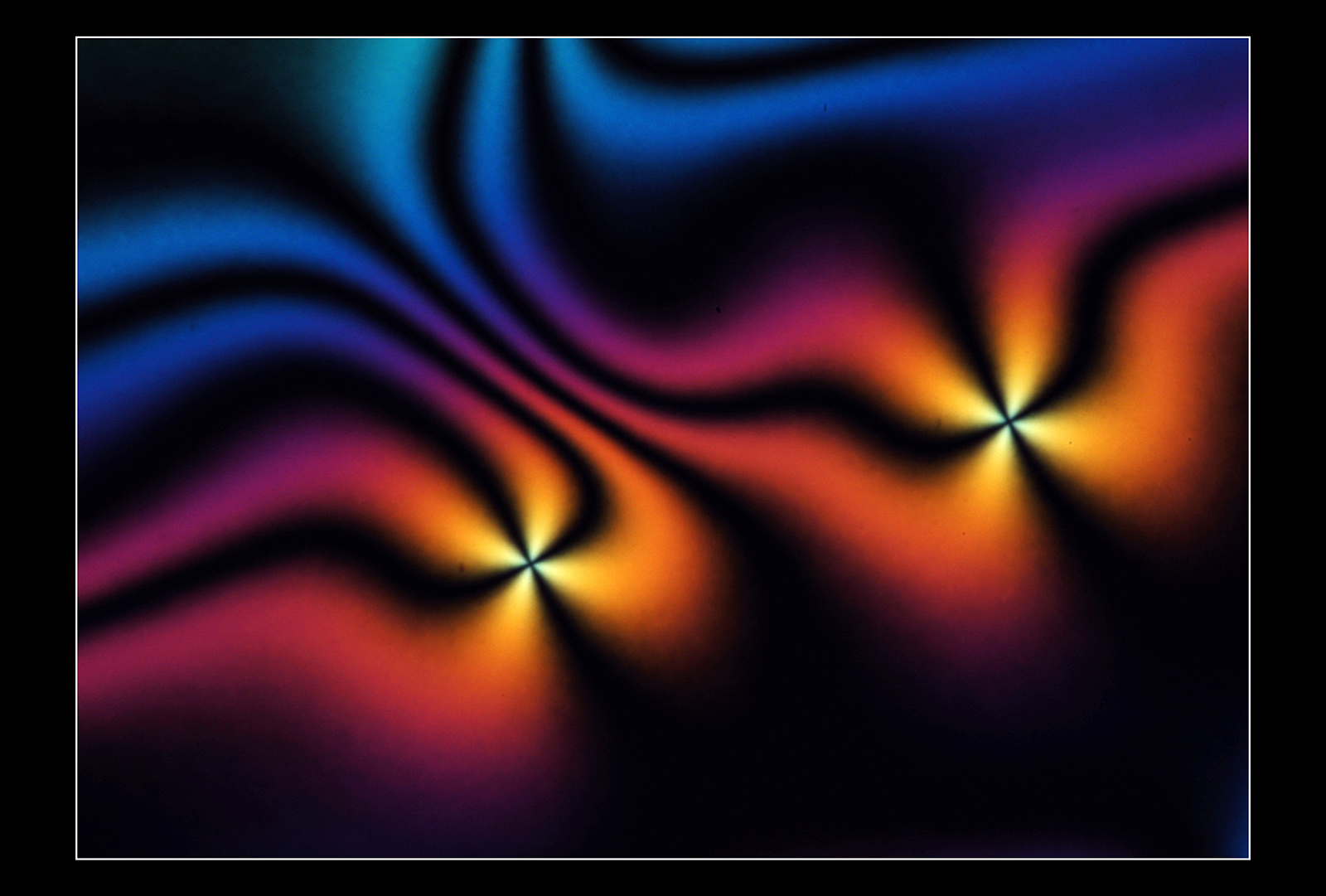
Focal conic domains
Liquid Crystal Institute, Kent State University, Ohio, U.S.A.
Smectic liquid crystals represent a hybrid of a two-dimensional fluid and a one-dimensional solid, being formed by membrane-like molecular layers that stack on top of each other. The layers are highly flexible and readily curve into sophisticated patterns. The curled layers, in order to keep their separation constant, must produce a certain set of singularities, i.e. line defects at which the smectic layers melt. These singularities are of a well-defined geometrical shape, such as a pair of an ellipse and a hyperbola. The resulting structures are called focal conic domains.
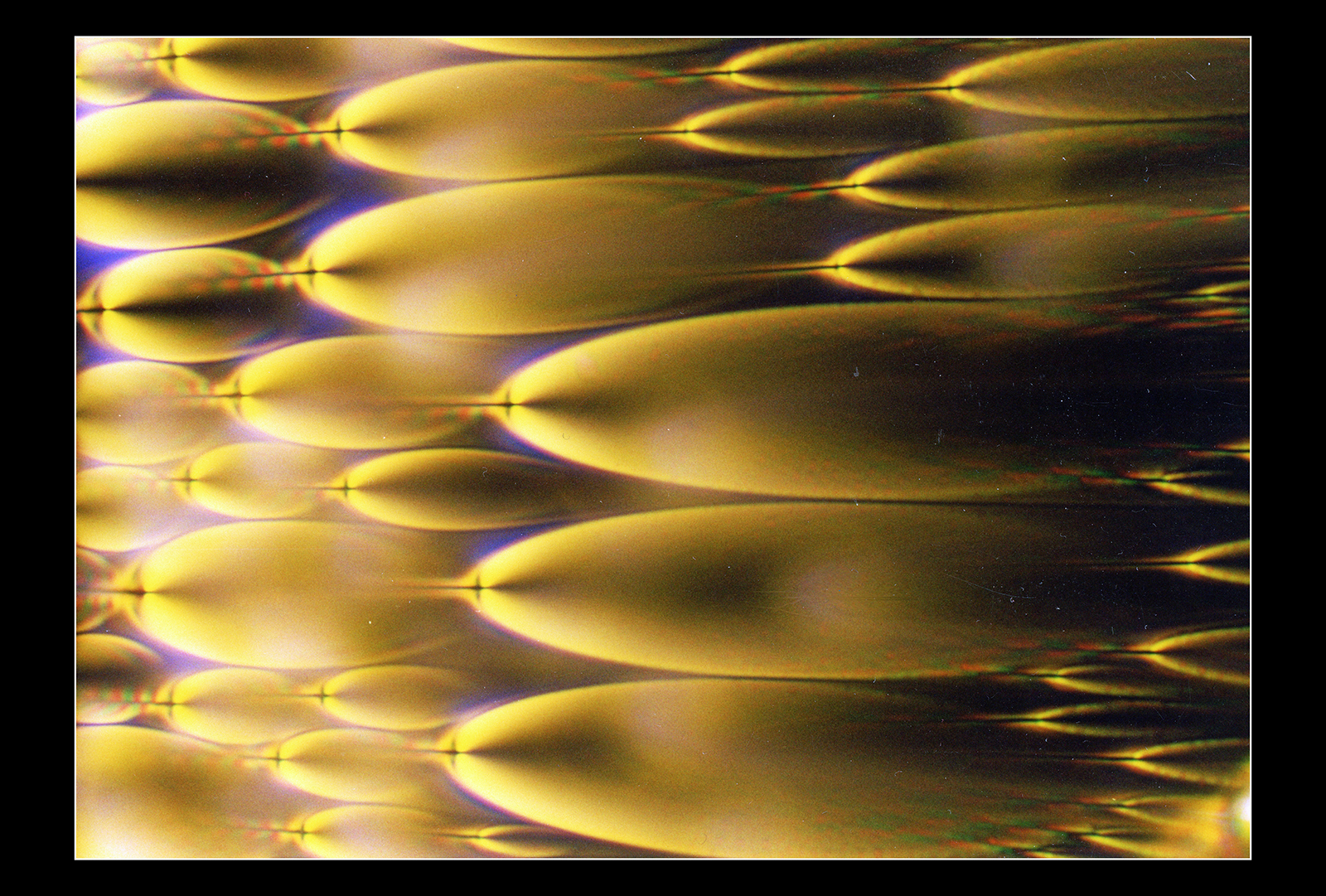
Heart-shaped defects
Jožef Stefan Institute, Ljubljana, Slovenia
Molecules in liquid crystals, which are used in liquid crystal displays, are on average oriented in one direction. Where this orientation abruptly changes, the so-called topological defects appear. The defects can be singular points, curved lines and sometimes – like this one – in the shape of a heart.
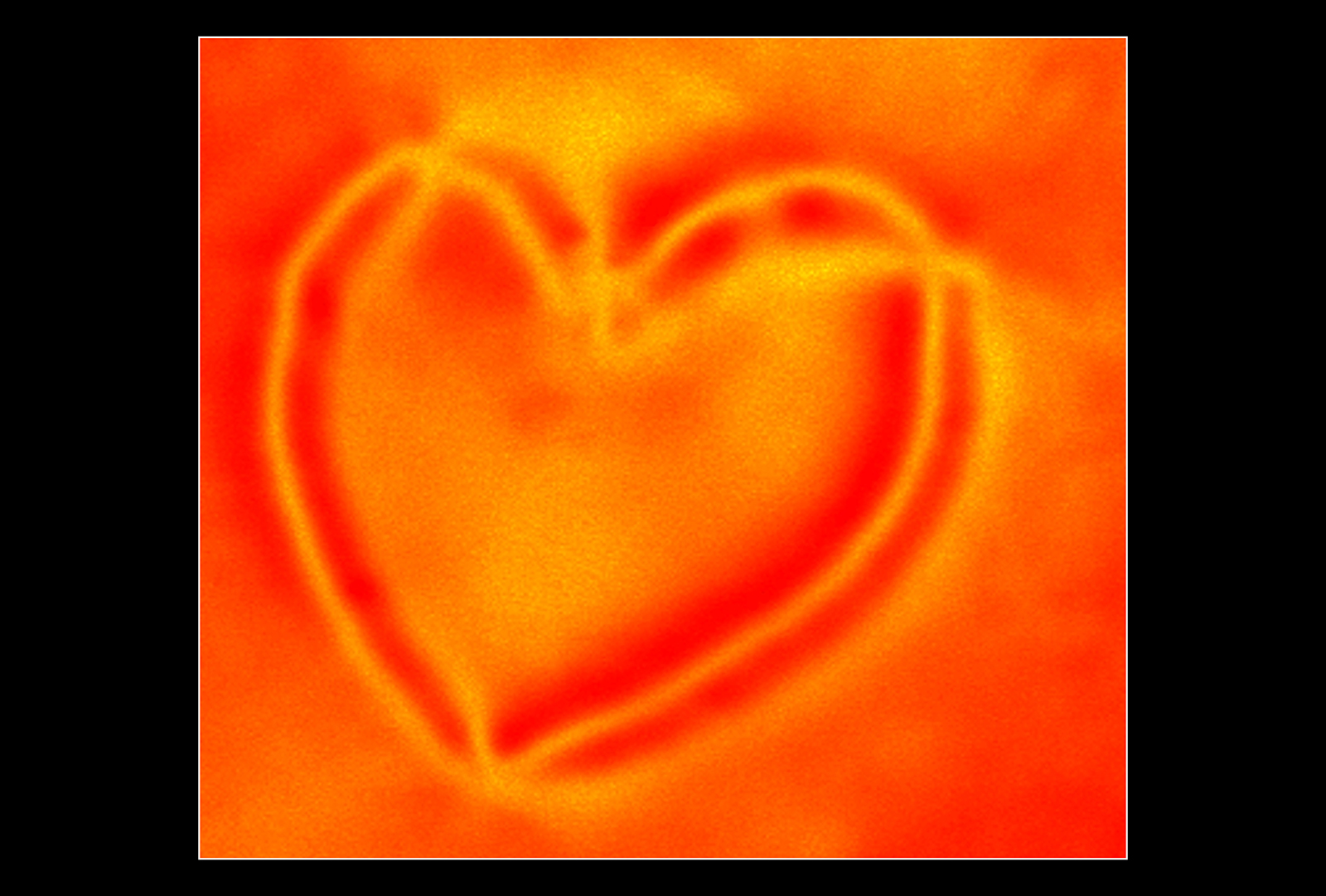
Sessile chiral liquid crystal droplet
Institute of Physical Chemistry, University of Stuttgart, Germany
Chalmers University of Technology, Gothenburg, Sweden
Chalmers University of Technology, Gothenburg, Sweden
The polarized optical micrograph shows a sessile droplet of 5CB nematic liquid crystal doped with (S)-mandelic acid on a rubbed polyimide glass surface. The glass provides uniform planar surface anchoring of the nematic director whereas the curved liquid crystal–air interface gives homeotropic boundary conditions. With this confinement we get a locally twisted hybrid director structure with a disclination line extending across the droplet. Chirality of the liquid crystal twists the disclination line into S-like shape.

Polymeric scaffold for fabrication of liquid crystal q-plate
Faculty of Mathematics and Physics, University of Ljubljana, Slovenia
Jožef Stefan Institute, Ljubljana, Slovenia
School of Physics, Nankai University, Tianjin, China
Jožef Stefan Institute, Ljubljana, Slovenia
School of Physics, Nankai University, Tianjin, China
Simplicity of arranging anisotropic properties of liquid crystals into complex patterns makes them ideal for producing filters for precise manipulation of light waves. On their own, liquid crystal structures are susceptible to change due to changes in temperature, pressure and even the light passing through them. A polymeric scaffold that holds the imprint of the structure, can stabilize the device. The polymeric network in this image is designed for a filter that “twists” a light wave by giving it angular momentum.
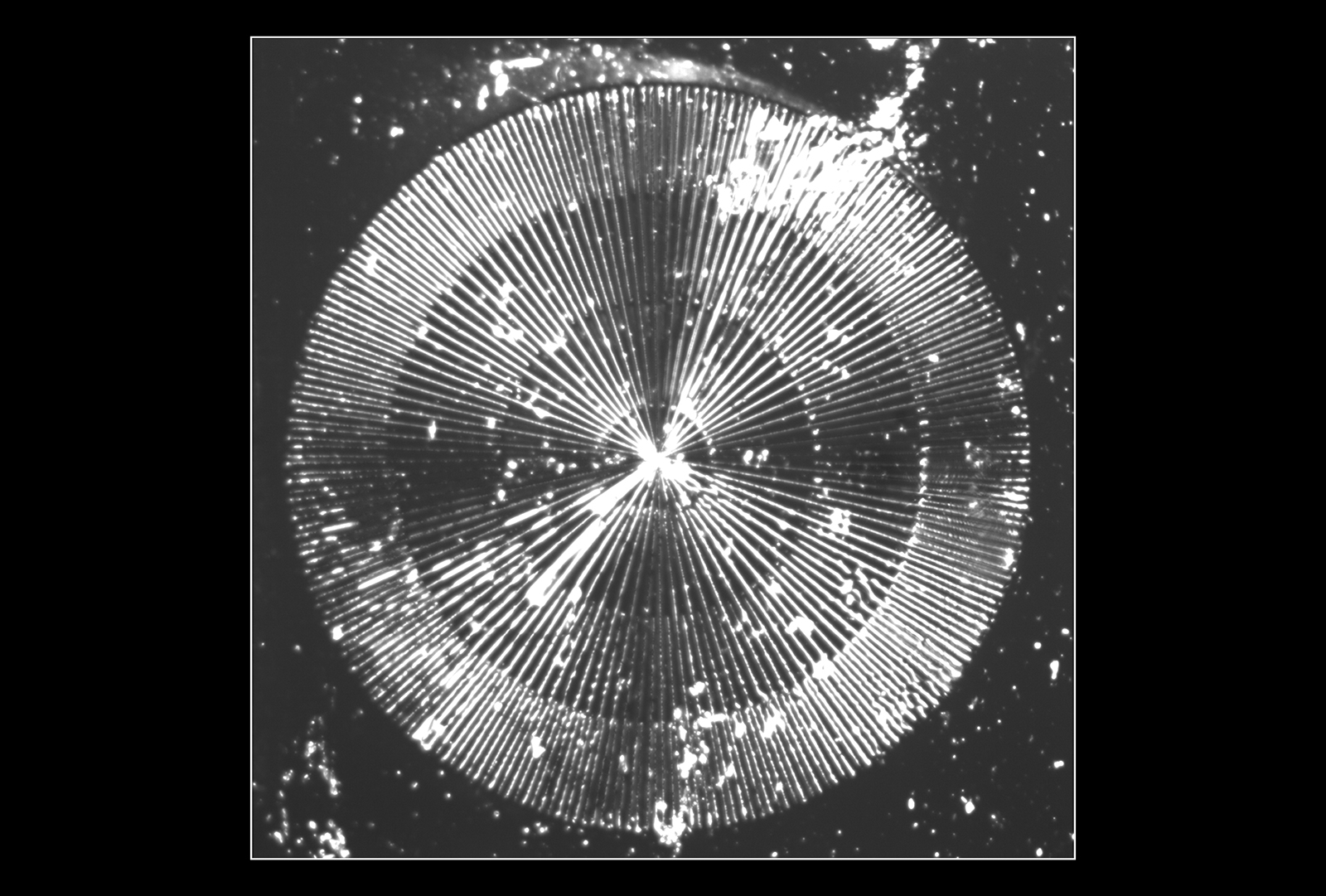
First 3D laser that emits light in all directions
Jožef Stefan Institute, Ljubljana, Slovenia
Faculty of Mathematics and Physics, University of Ljubljana, Slovenia
Faculty of Mathematics and Physics, University of Ljubljana, Slovenia
The schematics shows a layered structure of the 3D laser which is composed of molecules rotating around an axis. The structure is embedded inside a droplet that is ten times smaller than the thickness of a human hair. The generated laser light is emitted from the center out in all directions.
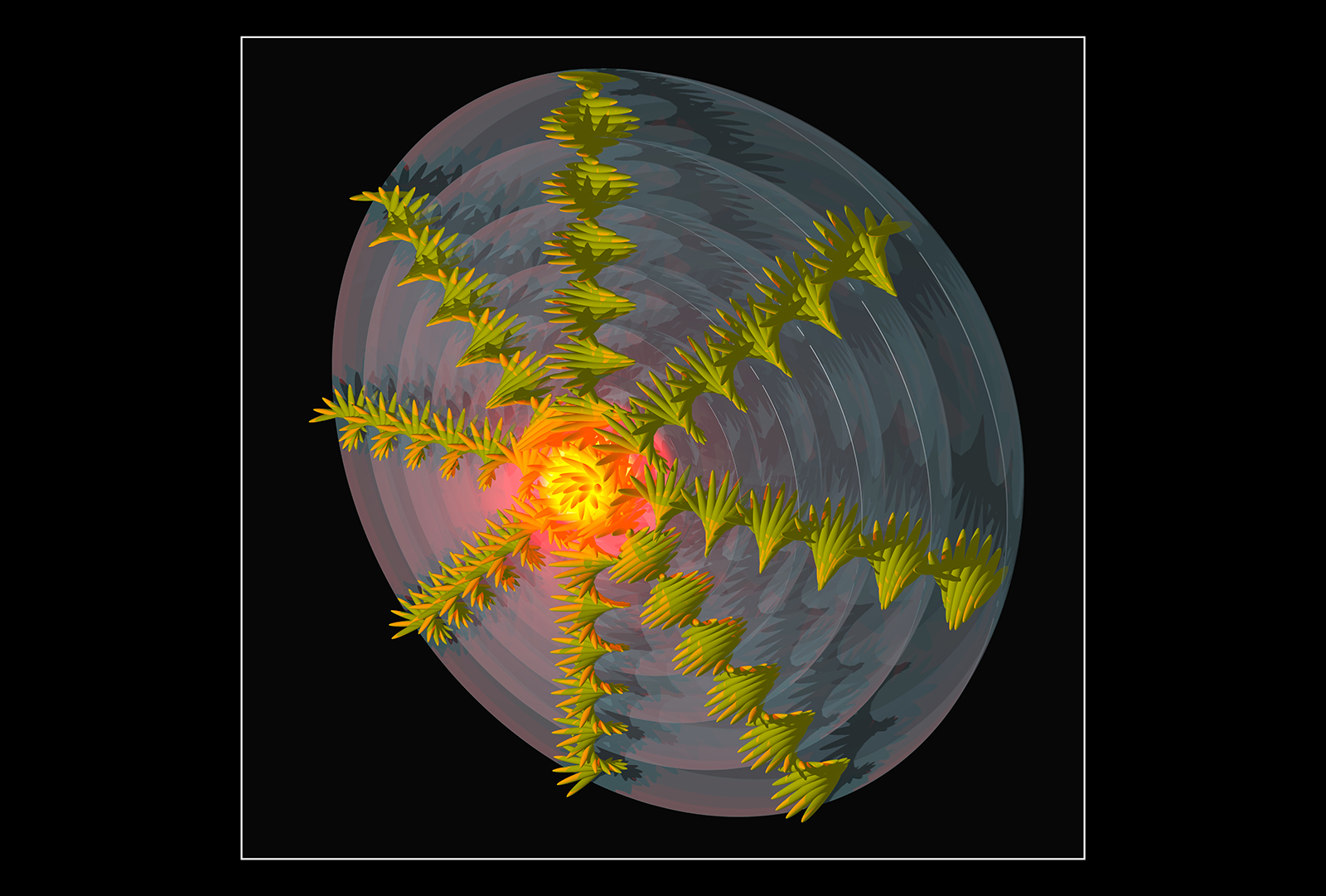
Twisted nematic pokeballs
Keio University, Tokyo, Japan
A computer simulation of a nematic liquid crystal fluid subjected to a perturbative twist elastic director field deformation. Modified, anisotropic, Lennard-Jones molecules are represented by directional spheres in a style reminiscent of pocket-sized monster receptacles.
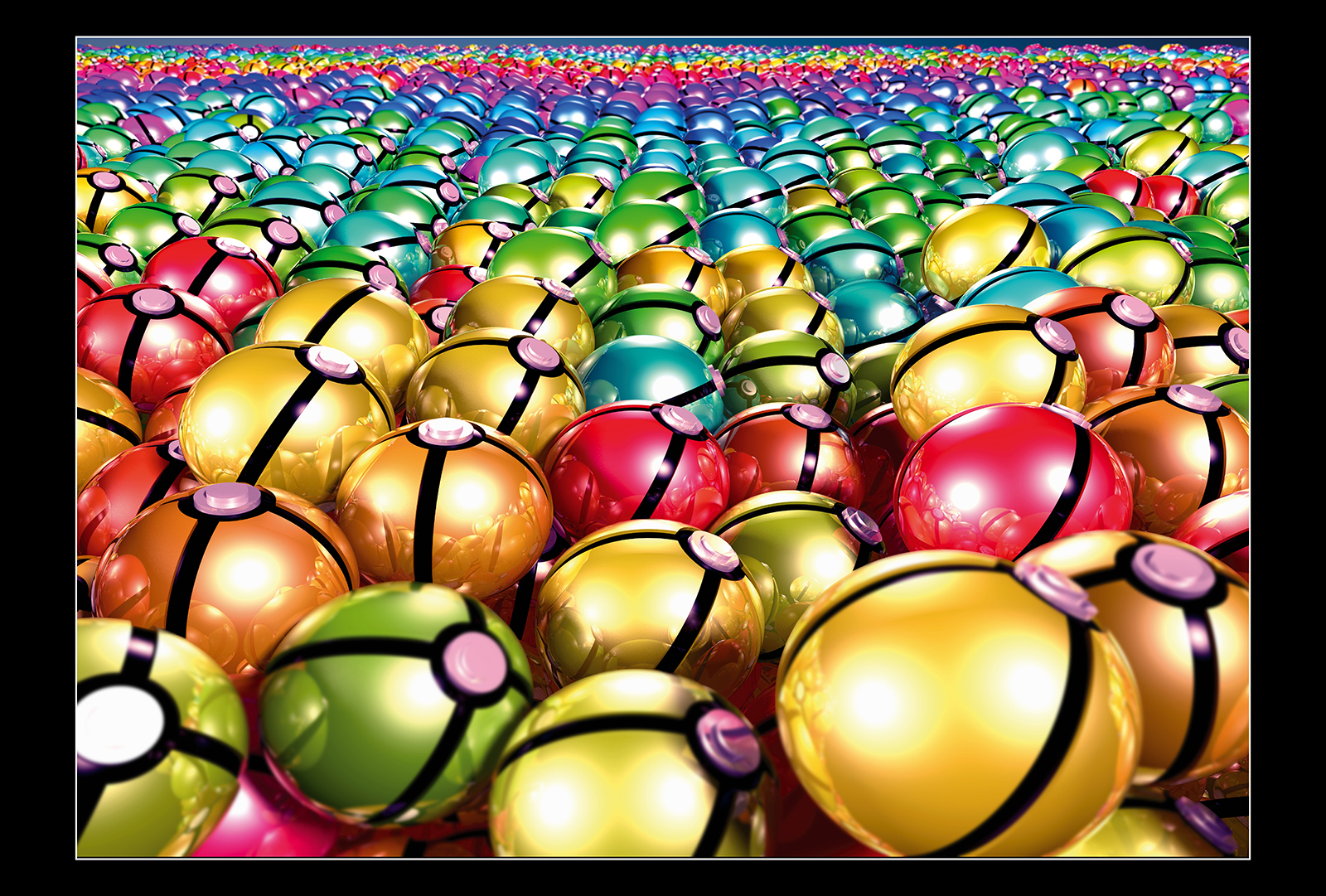
Carnival at the nanoscale – an all-DNA hydrogel
Institute for Complex Systems, Sapienza University of Rome, Italy
Thanks to its outstanding specificity, DNA can be used in material science as a building block. The picture shows a simulation snapshot of a hydrogel made of tetravalent DNA nanostars. The system has been simulated with a realistic coarse-grained model of DNA.

Stars in the void – star polymers bathing in a colloidal crystal
Institute for Complex Systems, Sapienza University of Rome, Italy
Colloidal crystals are suitable for numerous optical technologies, such as photonic crystals and filters, as their stacking planes naturally manipulate light via diffraction. Precise control over the crystal structure is generally required for these applications, and defects often naturally arise due to polymorphism. Here we show patchy colloids, which naturally self-assemble into low-density crystals, and star polymers, whose shape and size select only one of the two competing structures compatible with the specific geometry of the colloids.
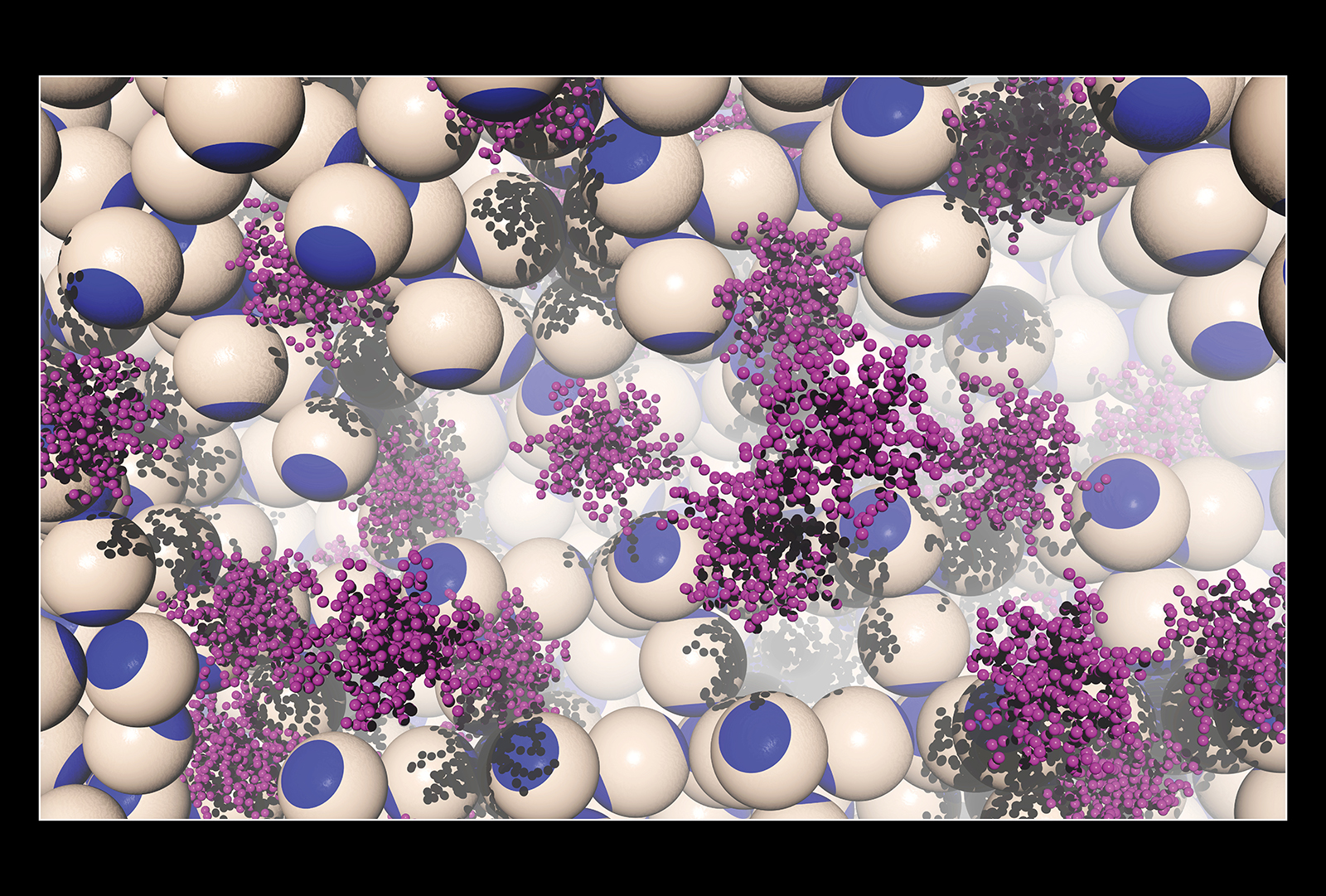
Super Carnot efficiencies in a colloidal heat engine
Max Planck Institute for the Physics of Complex Systems, Dresden, Germany
Complutense University of Madrid, Spain
University College London, United Kingdom
Max Planck Institute for Molecular Cell Biology and Genetics, Dresden, Germany
Complutense University of Madrid, Spain
University College London, United Kingdom
Max Planck Institute for Molecular Cell Biology and Genetics, Dresden, Germany
In the macroscopic world, Carnot efficiency is the ultimate limit in efficiency of heat engines, owing to the second law of thermodynamics. On the micoscopic scale, the fluctuating nature of thermal motion can break this limit for small number of cycles. The image shows the distribution of measured efficiencies of a single-particle heat engine with increasing number of cycles on the vertical axis. Super Carnot efficiencies appear even far from the quasistatic limit.

Seeing the invisible – airflows generated by an impacting drop
MIT, Massachusetts, U.S.A.
James Franck Institute, University of Chicago, Illinois, U.S.A.
James Franck Institute, University of Chicago, Illinois, U.S.A.
We use a modified Schlieren optics technique combined with high-speed imaging to visualize the airflows induced by the impact and spreading of a liquid drop. Air structures emerge on different length scales. On large scales, the airflow induced in the drop’s wake leads to vortex structures due to interaction with the substrate. On smaller scales, we visualize a ring structure above the outer edge of the spreading liquid generated by the spreading of the drop. The vorticity is governed by a balance between inertial and viscous forces in the air.
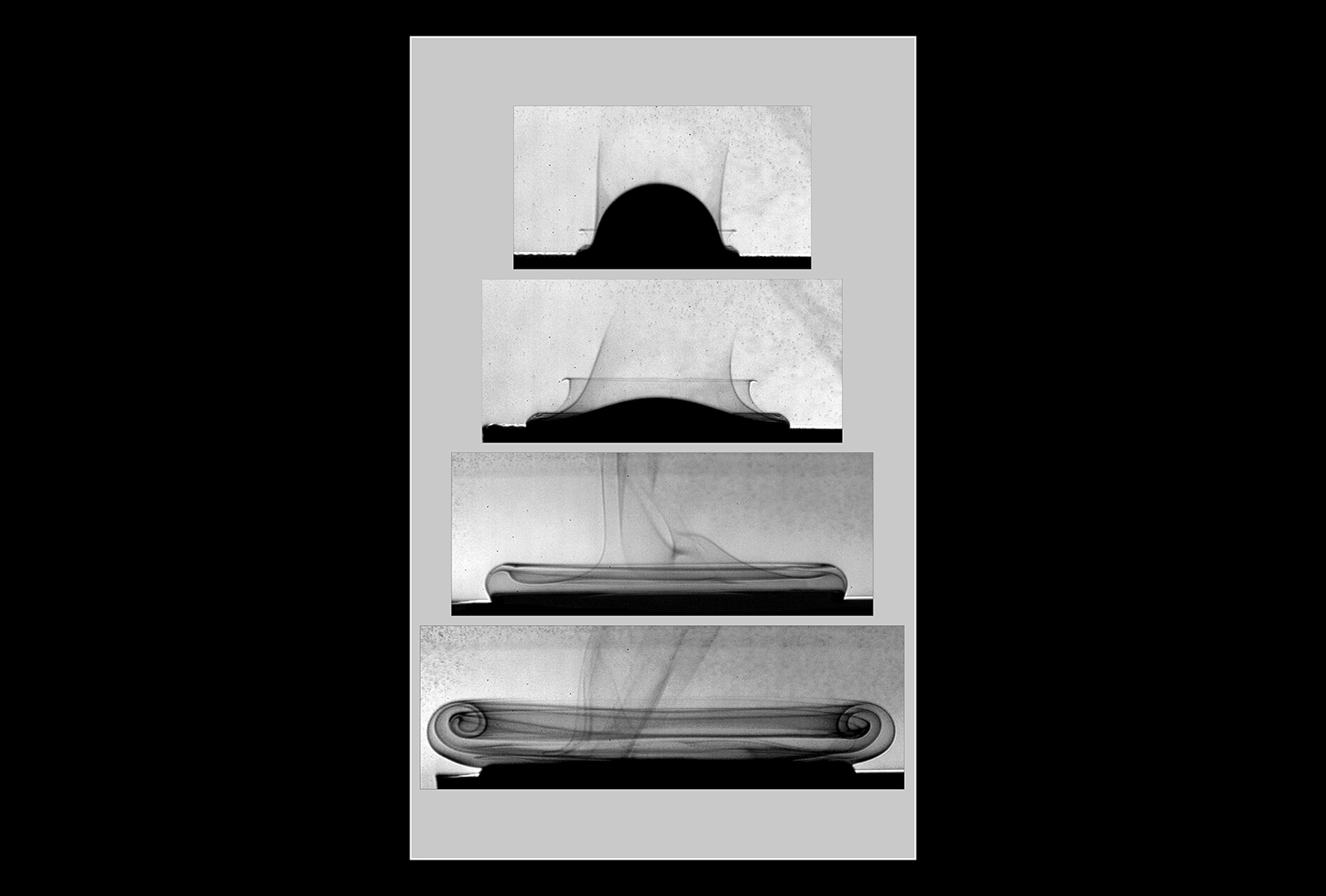
Laser light-induced structure in polybutadiene/tetradecane solution
Foundation for Research and Technology – Hellas, Heraklion, Crete, Greece
University of Crete, Heraklion, Crete, Greece
Max Planck Institute for Polymer Research, Mainz, Germany
University of Crete, Heraklion, Crete, Greece
Max Planck Institute for Polymer Research, Mainz, Germany
Observation of the unexpected formation of permanent structures upon mild laser illumination in transparent, viscous and non-absorbing cis-1,4 polydiene solutions in organic solvent of lower refractive index. The structure formation arises from local variations in the refractive index due to changes of polymer concentration along the beam propagation axis. Here, in polybutadiene/tetradecane solution, prolonged irradiation leads to local increase of refractive index and the achievement of “massive” writing. The response of the polybutadiene solutions to red laser light was observed through phase contrast optical microscopy.
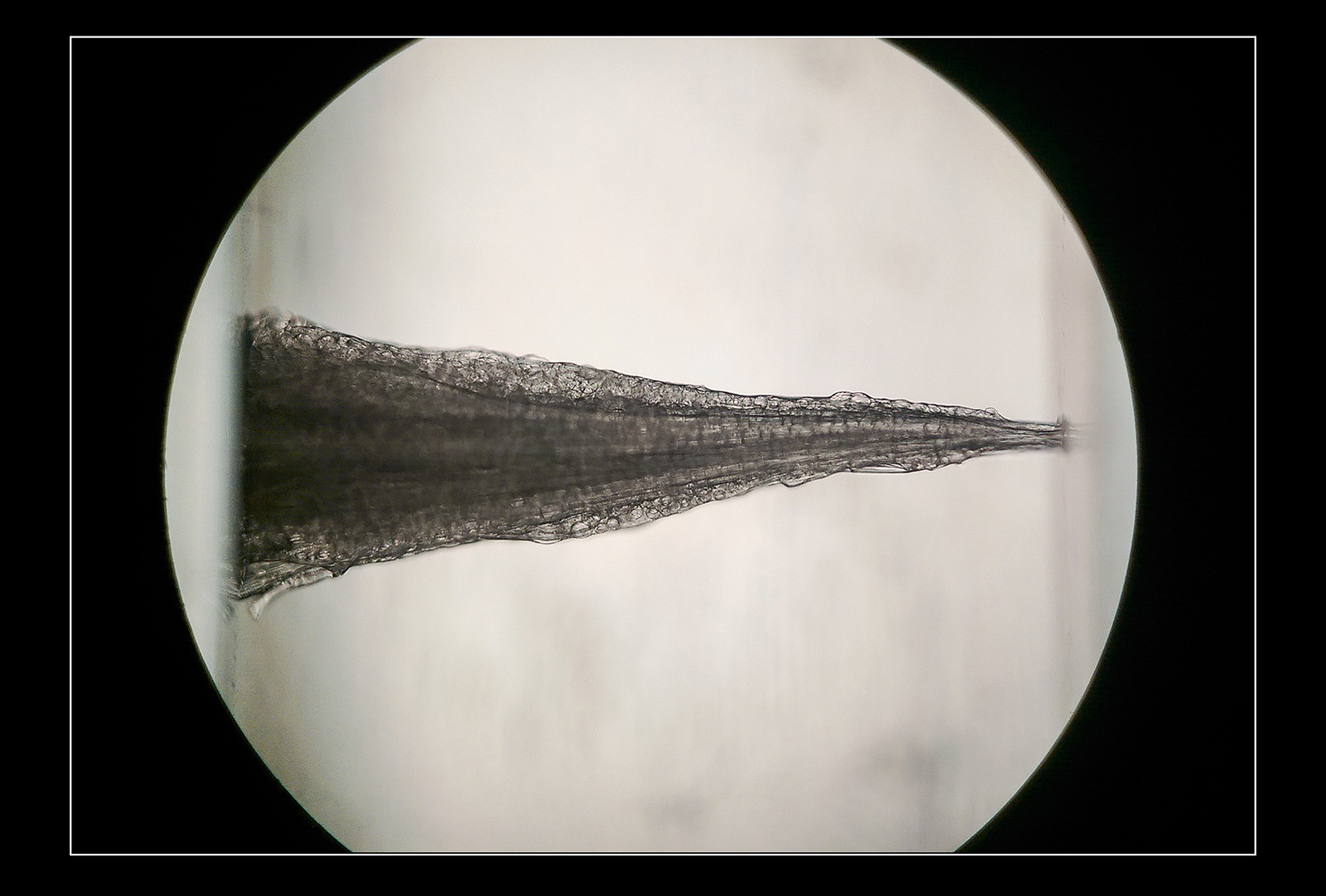
Colloidal crystal of cubes
Debye Institute for Nanomaterials Science, Utrecht University, Netherlands
Soft Matter Physics, University of Konstanz, Germany
Faculty of Science, Lund University, Sweden
Soft Matter Physics, University of Konstanz, Germany
Faculty of Science, Lund University, Sweden
Colloidal cubes with rounded edges, also known as superballs, spontaneously order into rhombic crystals. The small angle X-ray scattering pattern, obtained using a special setup with microradian resolution, clearly reflects the building block shape and the structure of the assembly.
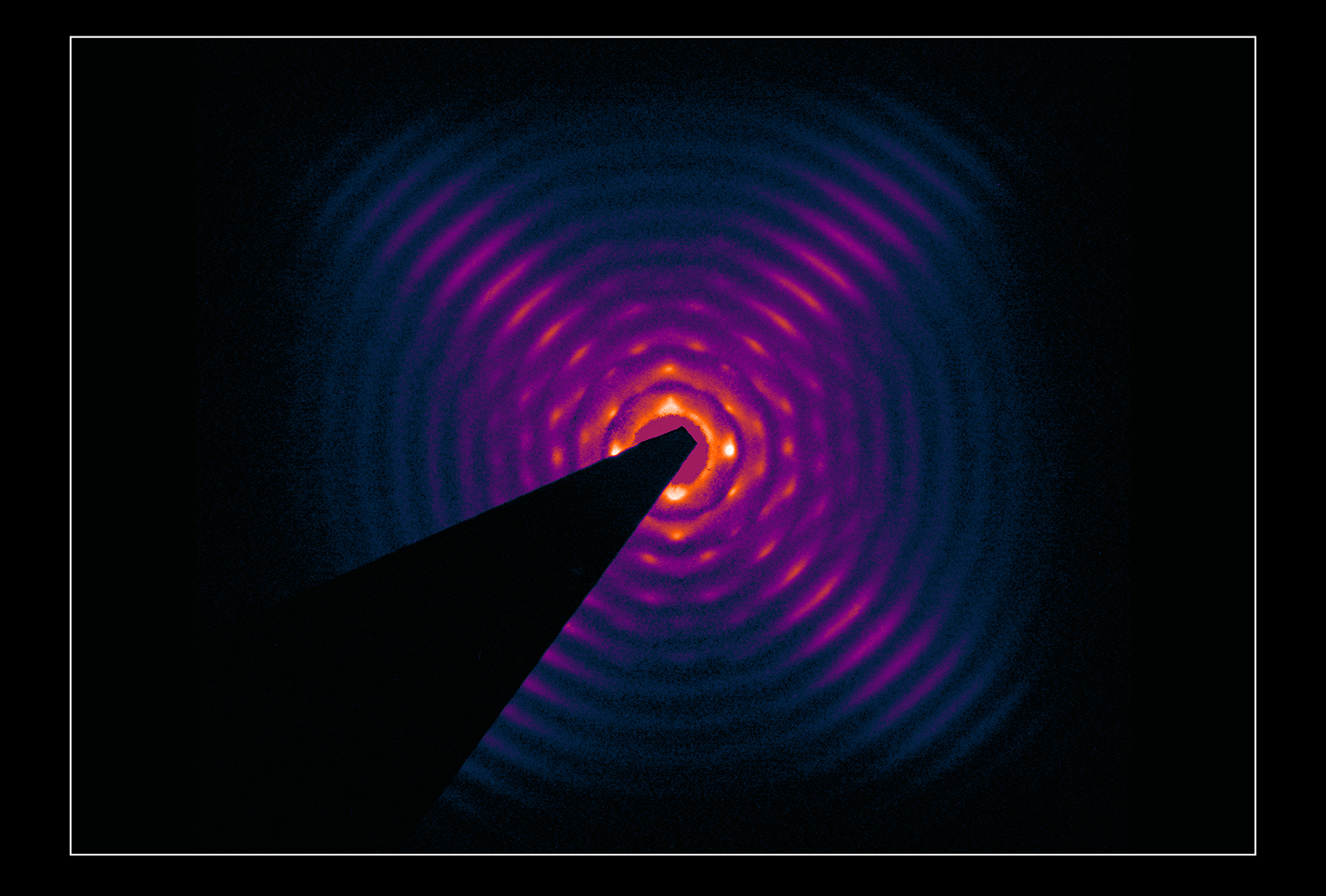
Patchy emulsion
Center for Soft Matter Research, New York University, New York, U.S.A.
A packing of silicone oil droplets in water, stabilized by fluorescently labeled phospholipids (DOPC) and cholesterol at the interface. These surface molecules phase separate to form stable patterns at the interface, including polka dots, belts, and caps of one phase in the other. These emulsions are transparent, allowing us to image them in three dimensions by confocal microscopy.
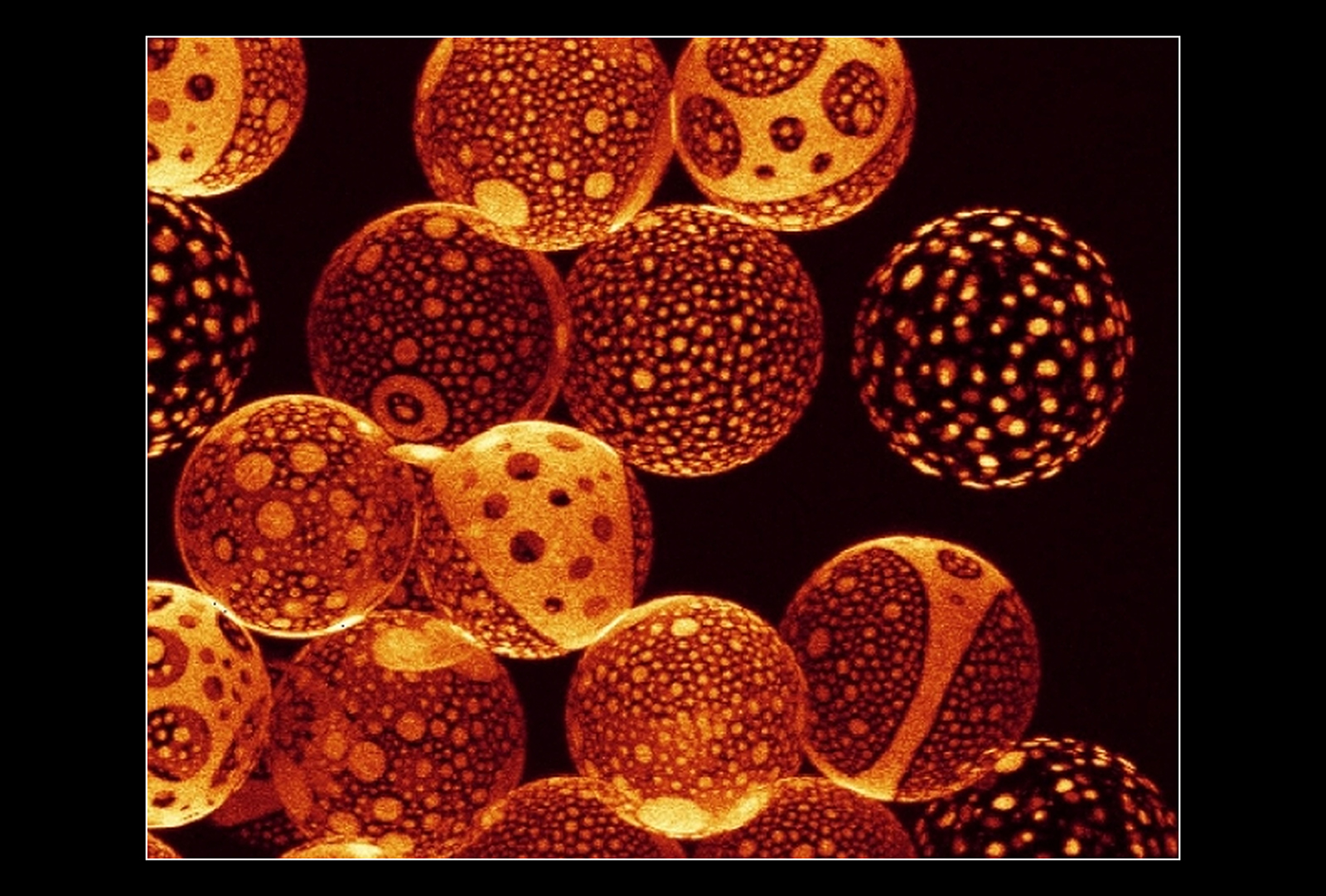
Viscous fingering instability
MIT, Massachusetts, U.S.A.
James Franck Institute, University of Chicago, Illinois, U.S.A.
James Franck Institute, University of Chicago, Illinois, U.S.A.
Fingering pattern created by the injection of a less viscous fluid into a more viscous one in a quasi-two-dimensional geometry. The fluids were confined between two glass plates and the less viscous fluid was dyed blue to be visible. The fingers in the pattern elongated and split repeatedly as more and more blue-colored fluid was pushed into the system.

DNA stars lighting up the nanoscale
Sapienza University of Rome, Italy
Exploiting the Watson-Crick base-pair pairing between different nucleotides (A-T, G-C) it is possible to design DNA sequences that self-assemble into stars at the nanoscale. Self-complementary single DNA sequences, the so-called sticky ends, are attached at the end of each arm in every nanostar permitting the connectivity between different nanostars. DNA nanostars are useful to experimentally investigate fundamental models of patchy colloids with controlled valence. Nanostar hydrogels have been also proposed as smart cargo nanodevices for drug delivery purposes in targeted cells.
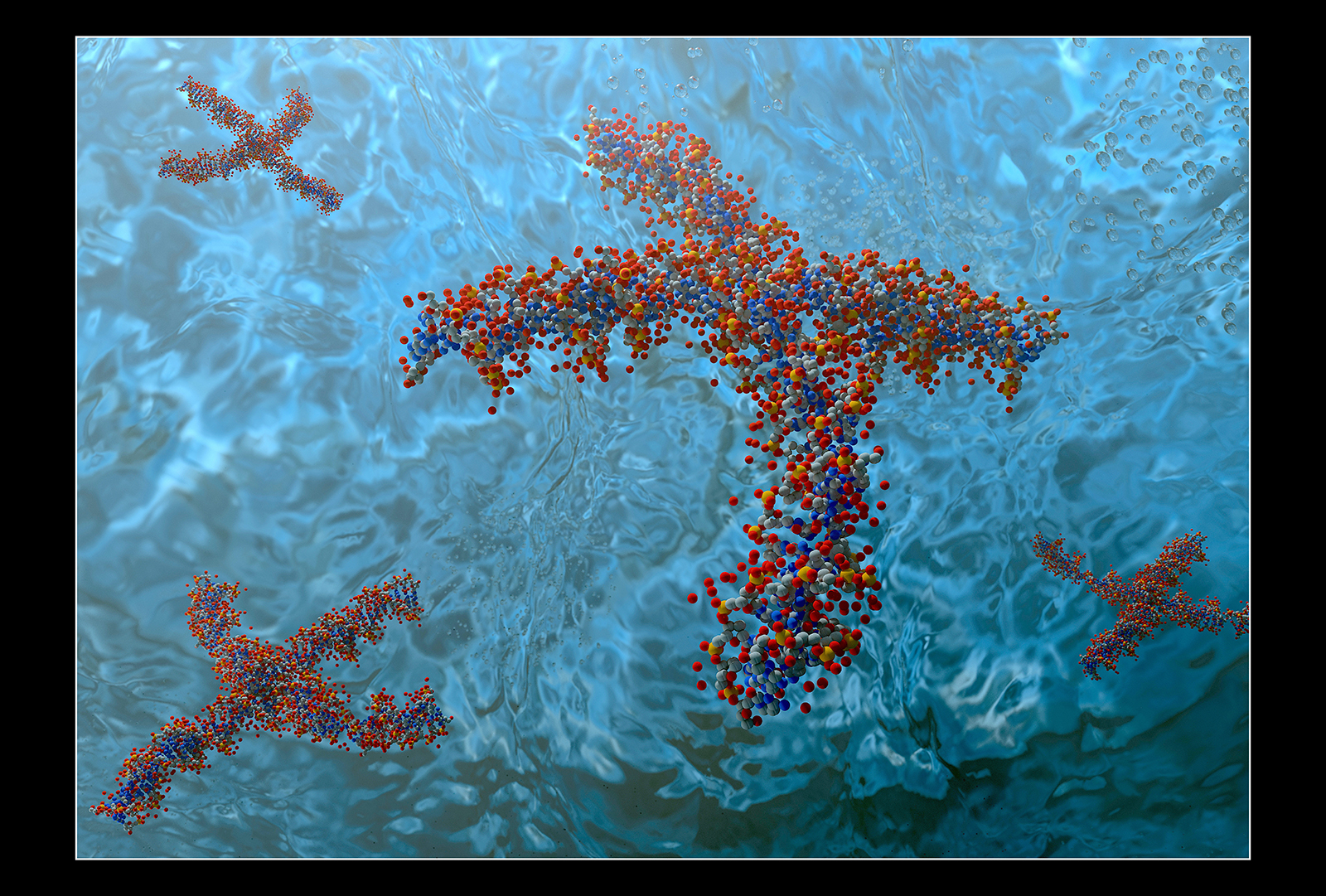
Liquid filled hourglass
ESPCI Paris, France
Liquid core hydrogel capsules dispersed in water are flowing through a bottleneck due to buoyancy at a constant rate, like an hourglass. Capsules of equal size can be quickly produced via breakup of compound liquid jets. They are suitable as microscopic bioreactors for experiments with cell cultures.
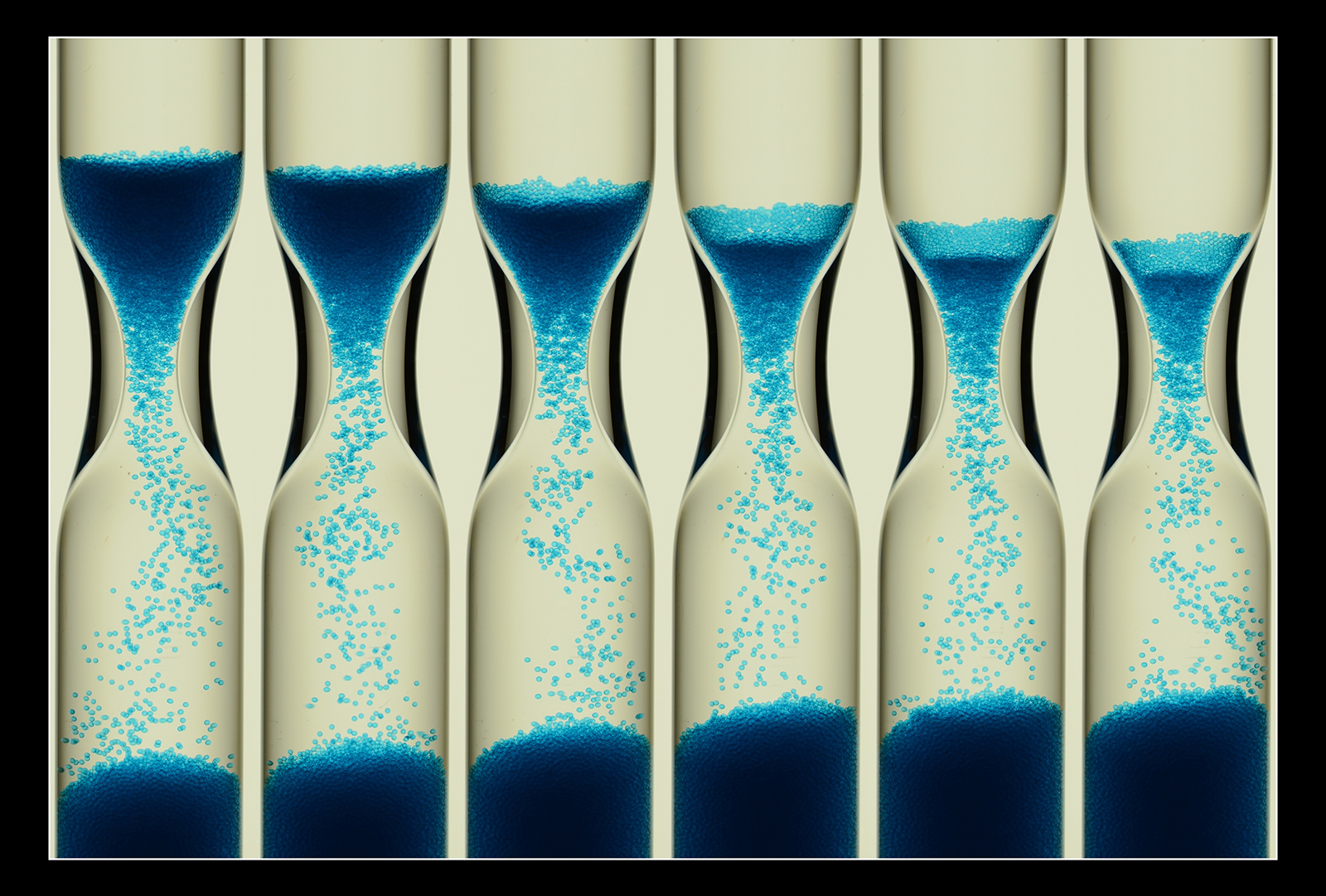
Fluid is faster!
Department of Applied Physics, Aalto University, Finland
Department of Physics & Astronomy, University of Pennsylvania, U.S.A.
Department of Physics & Astronomy, University of Pennsylvania, U.S.A.
A series of photographs of discharging cylindrical hopper with glass beads and red dye, submerged in a large tank of water. Initially a layer of red dye is injected on top of the granular packing. After the plug is removed the grains start to discharge creating a pumping effect. This sucks the dye into the granular packing with superficial velocity higher than the grains’ velocity. This counterintuitive fluid-is-faster effect is due to the dilation of grains while exiting the hopper. The grains move further apart at the exit while the space is filled with water that is pulled through the entire column of grains.
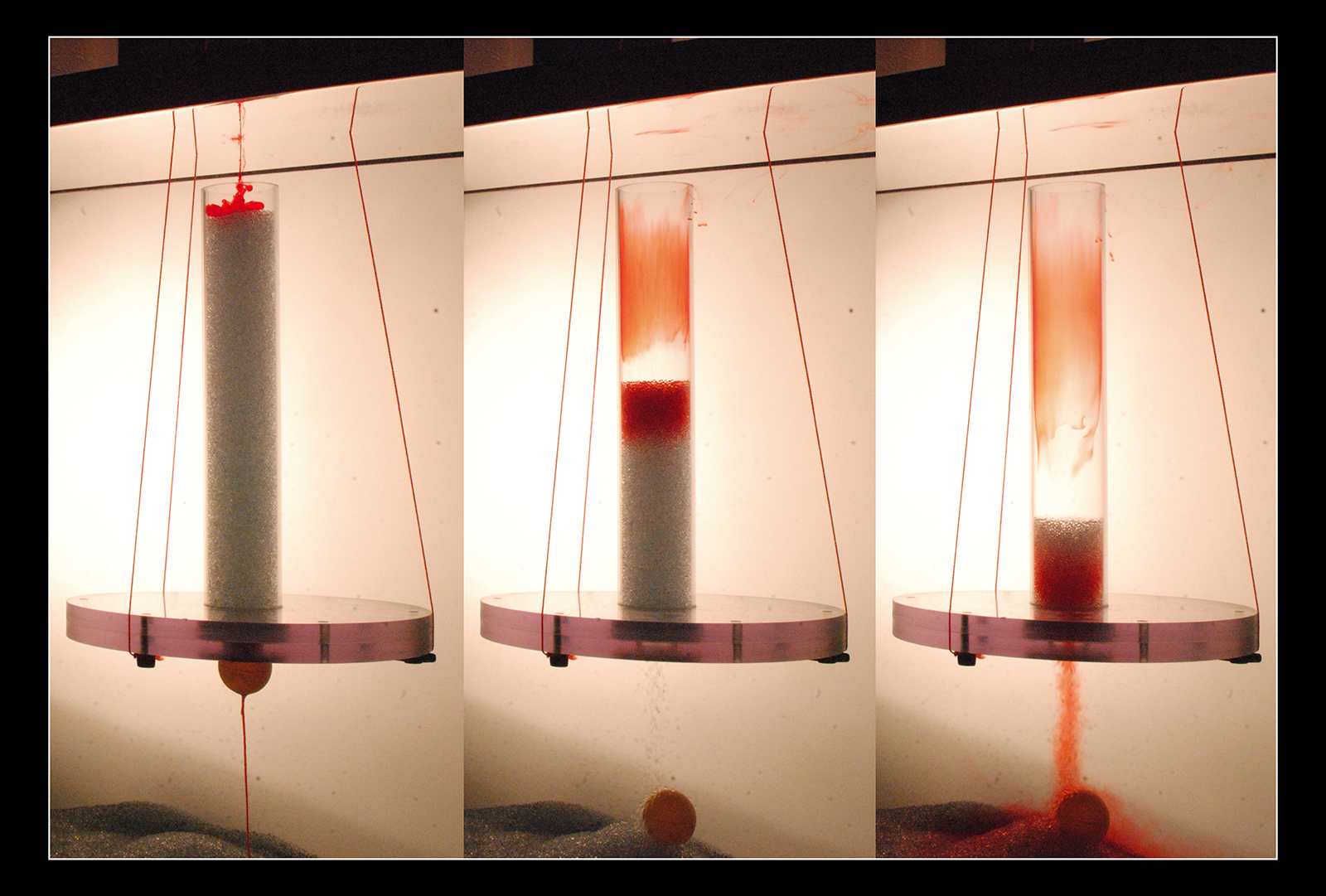
Computer simulations of a sheared nanoclutch
Institute for Theoretical Physics, Technical University of Berlin, Germany
Sheared nanoclutch consisting of colloids confined between two independently driven rings, providing a potent model system for simulations and experiments. Shear is applied by driving the outer ring via optical traps and the paramagnetic particles of the inner ring via a rotating magnetic field. This induces complex dynamics and rheological response on the nanoscale.
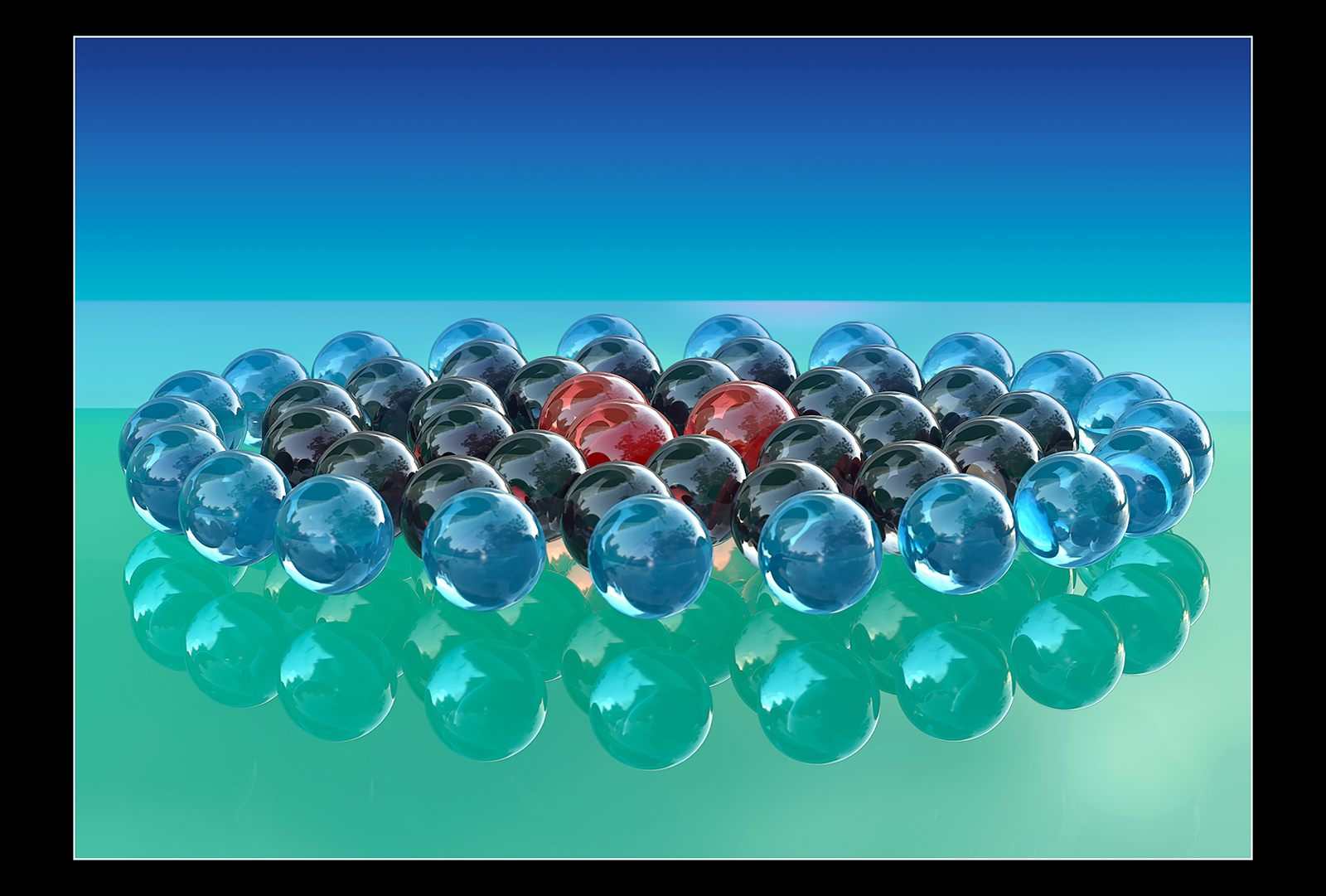
Jammed lattice monolayer of hard rods
Computational and Theoretical Soft Matter/Nanoscience, Institute for Applied Physics, University of Tübingen, Germany
A lattice system of hard rods at a surface (a monolayer) is captured here in a moment during non-equilibrium growth. A simple addition of an anisotropic substrate force that favors lying rods (blue and yellow) – as opposed to standing ones (magenta) – introduces non-equilibrium jammed states during growth. These jammed states are fully packed monolayers that have no equilibrium counterpart.
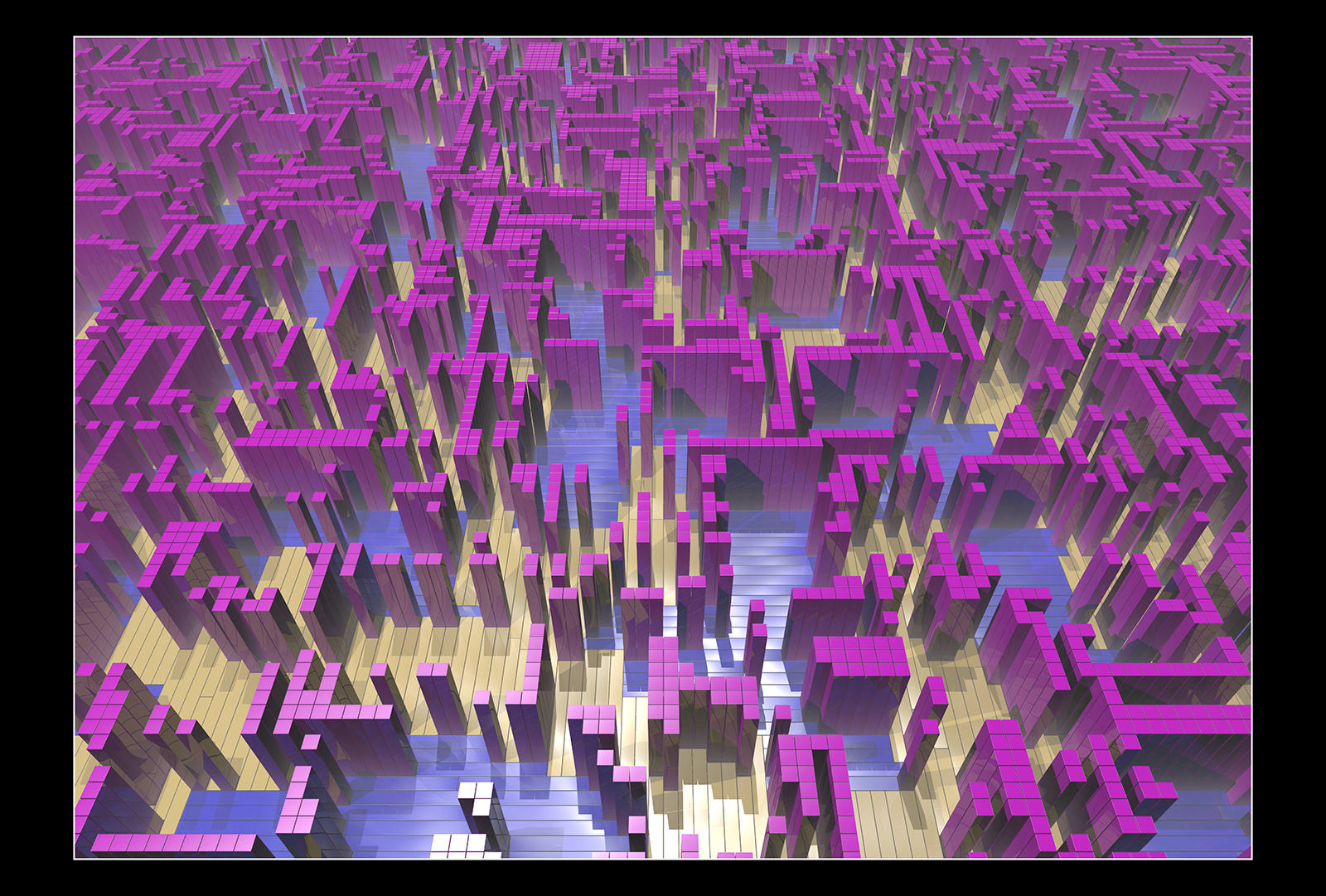
TiO2 nanotubes are stealing lipids from the membrane structures of the lung epithelial cells
Jožef Stefan Institute, Ljubljana, Slovenia
Image of the TiO2 nanoparticles (red) that interact with membranes (green) close to the upper surface of the LA4 lung epithelial cells taken with STED super-resolution microscope. Besides plasma membrane structure the green color reveals many ciliae and microvillae as well, the structures that are responsible for sensing the external environment and/or making contact with the substrate or other cells. While the red color codes the position of the individual or aggregated nanoparticles, the yellow color indicates nanoparticles coated with lipids which are stolen from cell membrane structures.
